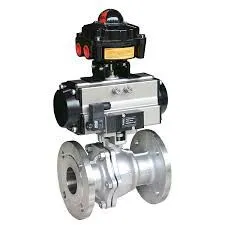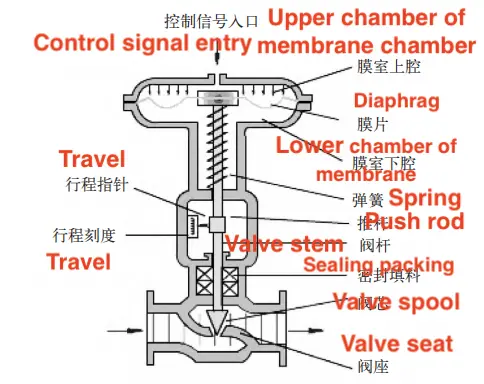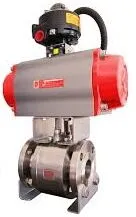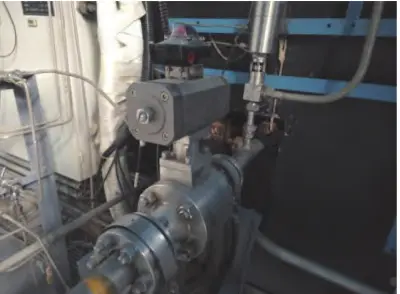Optimizing Material Selection in Pneumatic Ball Valves
Nov 26, 2024
On this page
Material selection and performance optimization directly impact the functionality of pneumatic ball valves. This paper systematically examines material selection and performance optimization in valve design to improve the efficiency and service life of pneumatic ball valves. Through analyzing material selection for key components—such as the valve body, core, seat, and stem—the reliability and service life of pneumatic ball valves can be significantly enhanced.
 Pneumatic ball valves are critical components in industrial automation control systems, where their operational quality directly influences production stability and reliability. The design of pneumatic ball valves encompasses material selection, performance optimization, structural design, manufacturing processes, and additional factors. Among these factors, material selection and performance optimization are essential to improving pneumatic ball valve performance. Accordingly, this paper provides an in-depth analysis of material selection and performance optimization in pneumatic ball valve design, with the aim of offering a theoretical foundation and practical guidance for optimizing valve performance.
Pneumatic ball valves are critical components in industrial automation control systems, where their operational quality directly influences production stability and reliability. The design of pneumatic ball valves encompasses material selection, performance optimization, structural design, manufacturing processes, and additional factors. Among these factors, material selection and performance optimization are essential to improving pneumatic ball valve performance. Accordingly, this paper provides an in-depth analysis of material selection and performance optimization in pneumatic ball valve design, with the aim of offering a theoretical foundation and practical guidance for optimizing valve performance.Pneumatic ball valves primarily consist of a valve body, ball, seat, stem, and actuator. The valve body serves as the main structure, providing pathways for fluid flow and connection points. The ball, typically spherical with a smooth surface, is a key component for controlling flow; it forms a seal with the valve seat to stop or permit flow. The seat, fixed within the valve body, ensures tight sealing with the ball when the valve is closed. The stem connects the ball to the actuator, transmitting the torque needed to control the ball's rotation. The actuator, generally comprising a cylinder and spring, supplies the force required to open and close the valve.
The operating principle of a pneumatic ball valve is illustrated in Figure 1. When the actuator receives a control signal, compressed air enters the cylinder, moving the piston and connecting rod, which rotate the stem and ball. When the channel in the ball aligns with the flow path in the valve body, the medium flows through. When the ball rotates 90°, misaligning the channels, the valve closes and blocks flow. The sealing surfaces between the ball and seat remain tightly pressed together due to medium pressure, ensuring a secure seal. The spring provides a return force, automatically closing the valve if air pressure is lost, thus ensuring system safety. By adjusting the air supply to the cylinder, the valve opening can be controlled, allowing for precise regulation of medium flow.

Figure 1 Working principle of pneumatic ball valves

Figure 1 Working principle of pneumatic ball valves
The operating environment of a pneumatic ball valve significantly influences material selection, considering factors such as medium type, temperature, pressure, and corrosiveness. Mechanical properties such as strength, hardness, and toughness determine whether the material can withstand the medium's pressure and external loads. Corrosion resistance is essential for the valve to withstand prolonged exposure to corrosive media, making it crucial to choose materials resistant to the medium’s properties. Sealing components, including the ball and seat, must have good wear resistance to withstand frequent operation. Additionally, the material’s processability directly affects manufacturing quality and cost, making it an important factor in material selection.
The valve body must resist medium pressure and external loads, requiring sufficient mechanical strength and rigidity to maintain structural integrity. It must also have adequate toughness to prevent brittle fracture under impact or thermal stress. Corrosion resistance is equally critical, necessitating materials suited to the medium’s corrosive characteristics. Common valve body materials include stainless steel, carbon steel, and alloy steel. Among these, 316L stainless steel is widely used in pneumatic ball valves in the chemical and pharmaceutical industries due to its excellent corrosion resistance, good mechanical properties, and ease of processing. For high-temperature, high-pressure, or highly corrosive environments, high-performance materials like duplex stainless steel or nickel-based alloys are suitable choices.
Selecting the valve core material requires consideration of factors such as wear resistance, corrosion resistance, and strength. Common materials for valve cores include stainless steel, cemented carbide, and ceramics. Stainless steel offers a good balance of properties and is suitable for various media environments. Cemented carbide, known for its high hardness and wear resistance, is ideal for demanding conditions, including applications involving chromium-cobalt-tungsten alloys. Ceramics offer excellent corrosion and wear resistance, though their low toughness makes them more suitable for specific applications with unique media requirements, such as zirconium oxide or silicon carbide.
The valve seat must possess high hardness and wear resistance to withstand wear from frequent rotation of the valve core. It must also provide good corrosion resistance to endure chemical erosion from the medium and should have high thermal stability to maintain sealing performance under temperature fluctuations. Common valve seat materials include cemented carbide and ceramics. Stellite alloy performs exceptionally well in challenging conditions, such as high temperatures, high pressures, and corrosive media, due to its outstanding wear resistance, corrosion resistance, and thermal stability. Tungsten carbide-based ceramics offer extremely high hardness and wear resistance, though their low toughness limits them to medium- and low-pressure applications without impact loads.
The valve stem experiences torsional and bending loads during operation, necessitating sufficient strength and rigidity to prevent deformation or breakage. The material must also have adequate toughness to withstand fatigue and impact loads. Additionally, the contact points between the valve stem, valve core, and sealing ring should exhibit excellent wear resistance to minimize clearance increases and leakage due to wear. Common materials for valve stems include stainless steel, high-strength alloy steel, and nickel-based alloys. Among these, 316 stainless steel is widely used in medium- to low-temperature and medium- to low-pressure conditions due to its balanced performance. For harsh conditions, such as high temperatures, high pressures, and corrosive media, high-strength alloy steel and nickel-based alloys are preferred for their superior mechanical properties and corrosion resistance.
In addition to the valve body, core, seat, and stem, pneumatic ball valves also contain packing, sealing rings, gaskets, bearings, sleeves, and other components. Material selection for these parts is equally important. The packing, which provides a seal between the valve stem and valve body, must have good compressibility, resilience, and wear resistance; common materials include polytetrafluoroethylene and graphite. The sealing ring provides a static seal between the valve core and valve seat, requiring high elasticity and resistance to various media. Fluororubber and nitrile rubber are common materials. The gasket, which compensates for manufacturing and installation variances, needs good compressibility and resistance to cold flow, with common materials including graphite composites and stainless steel. Components such as bearings and sleeves require good wear resistance and self-lubricating properties, with copper-based powder metallurgy and oil-impregnated copper bearings commonly used.
Previous: Manufacturing of High-Pressure Cryogenic Ball Valves for LNG Devices
Next: Optimization of Pneumatic Ball Valves


